Secret Marsh/Y Gors Gudd Nature Reserve, Freshwater East, Pembrokeshire, South Wales
Designations: Adjacent to the Pembrokeshire Coast Path
Below: The bird hide at Secret Marsh Nature Reserve
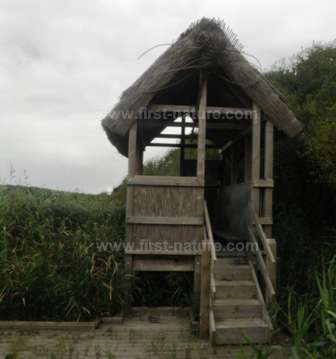
This lovely nature reserve is fronted by a beach served by a good path from the Freshwater East car park. The nature reserve itself can be found at the rear of the car park
Secret Marsh Nature Reserve is adjacent to the Pembrokeshire Cost Path and is owned and managed by the Pembrokeshire Coast National Park Authority.
Directions
Grid Ref: SS018975
From Tenby in Pembrokeshire follow the A4139 in a westerly direction passing through Lydstep. At Jameston follow the unmarked road signed towards Freshwater East. The car park will be on the right hand side of the road once you arrive at Freshwater East.
Access
The path into the nature reserve is level and leads to a boardwalk through the marsh. There are benches along the boardwalk and it leads to a bird hide. This nature reserve is accessible for both wheelchair users (provided the entrance is not too wet and boggy following heavy rain) and for prams.
Facilities
There are no facilities at the reserve but there are cafes, pubs, shops and public toilets in the nearby villages.
Description of Site
Below: The pond and boardwalk at Secret Marsh Nature Reserve
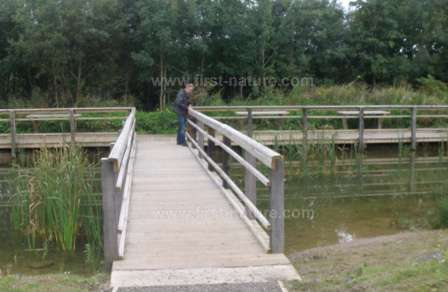
Just inside the entrance to Secret Marsh Nature Reserve there is a man-made pond - see picture on the right - which has had no introductions of plants or insects. It is simply being left to nature to develop and already there are good growths of rushes and evidence of thriving insect life. We saw dragonflies and damselflies during our visit in mid-September.
Above all Secret Marsh Nature Reserve is a very good place for birdwatchers. The marsh and the reeds are habitats which are in steep decline throughout the UK due to drainage for agricultural purposes and to build houses and other developments. If you walk quietly along the boardwalk, or sit on one of the benches or in the bird hide that overlooks a large expanse of reedbed, you could expect to see several bids species that are dependent on this type of habitat for their survival: Whitethroat, Marsh Tit, Reed Bunting, Sedge Warbler, Grasshopper Warbler, Water Rail and Snipe are all recorded from this lovely reserve. In spring Cuckoos are sometimes heard calling from the reeds.
Below: Soapwort
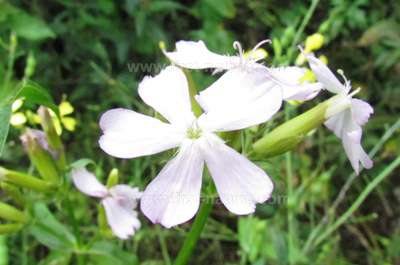
Below: Bouncing Bett, a double-flowered cultivar, is a garden escape that also nthrives at Secret Marsh Nature Reserve.
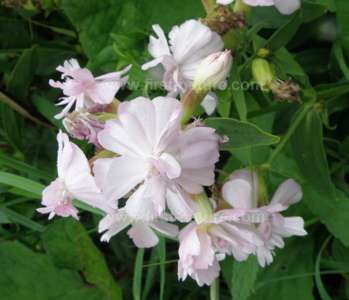
Secret Marsh Nature Reserve is also a good place to see many coastal species of wildflowers as well as some special species that thrive in marshy ground. In May and June the Yellow Flag Iris brightens up the edges of the reedbeds, and growing lower down in the water is the bright yellow Marsh Marigold. Towards the end of the season parts of the reserve have large displays of Soapwort and its close relative, called Bouncing Bett, which is a cultivar with double flowers. Soapwort has pale pink flowers and is poisonous, but despite this it has been used in the past to produce froth or a 'head' on beer. It has an interesting history of usage in Wales where it was made into a special soap for delicate cleaning and preservation of fabrics in woollen mills. Since then it has become widely naturalised in the countryside and can be found in a number of habitats including roadside verges.
Below: One of the beautifully carved benches to be found along the boardwalk in the reserve
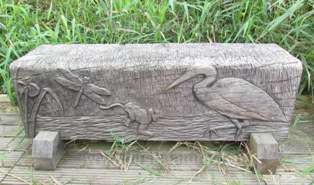
Secret Marsh Nature Reserve is an interesting place to visit at any time of the year: in spring there are early flowers, and in summer the migrant birds who visit to build their nests and raise their young are busy hunting for food throughout the reserve. Once the weather warms up myriad insects put in an appearance and you can expect to see several dragonfly and damselfly species, butterflies and moths. In winter you may well be surprised by some unusual bird species that stop off in bad weather to take a rest during their arduous migration journeys from northern Europe to the south.